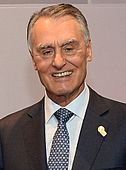Portuguese legislative election, 1991
|
|
|||||||||||||||||||||||||||||||||||||
|---|---|---|---|---|---|---|---|---|---|---|---|---|---|---|---|---|---|---|---|---|---|---|---|---|---|---|---|---|---|---|---|---|---|---|---|---|---|
|
|||||||||||||||||||||||||||||||||||||
|
230 seats to the Portuguese Assembly 116 seats needed for a majority |
|||||||||||||||||||||||||||||||||||||
|
|||||||||||||||||||||||||||||||||||||
|
|||||||||||||||||||||||||||||||||||||
| Portugal |
 This article is part of the series: |
This article is part of the series:
Politics and government of
Portugal
The Portuguese legislative election of 1991 took place on 6 October. The Social Democratic Party, under the lead of Cavaco Silva, won a historic third term and won with an absolute majority for the second consecutive turn, achieving a higher share than in the previous election, losing, however, 13 MPs due to the reduction of the overall number from the original 250 to 230. Cavaco Silva became the first Prime Minister since Hintze Ribeiro in 1904 to lead a party into three successive democratic election victories.
The Socialist Party, at the time led by Jorge Sampaio, the future President of Portugal, increased the share by 7% and gained 12 MPs, but did not manage to avoid the absolute majority of the Social Democrats. In the first legislative election after the fall of the Eastern Bloc, the communist dominated Democratic Unity Coalition lost much of its electoral influence, losing 14 MPs and 4% of the voting.
On the right, the CDS could not recover its past influence, mainly to the effect of tactical voting for the Social Democratic Party by right-wing voters, increasing its parliamentary group by only 1 MP. The National Solidarity Party, using a populist campaign, achieved for the first time an MP, in what would be the only presence of such party in the Parliament.
Voter turnout fell to 67.8%, and for the first time below 70% of the electorate.
...
Wikipedia


